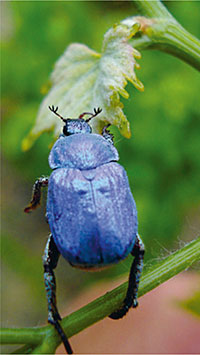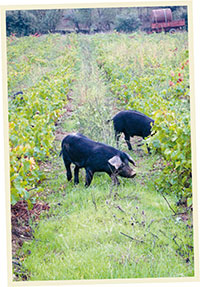
“The nation that destroys its soil destroys itself.”
(FRANKLIN D. ROOSEVELT, LATE PRESIDENT OF THE UNITED STATES)
When Dr. Grace Augustine, a botanist in James Cameron’s film Avatar (2009), marches into the control room at Hell’s Gate and lets rip at the Head of Mining Operations for bulldozing a hallowed, willow-like tree, I am sure that most people in the audience don’t recognize her description of trees on Pandora: “What we think we know is that there is some kind of electrochemical communication between the roots of the trees, like the synapses between neurons.” Sci-fi? Think again.
While Pandora itself is the stuff of legend, tree communication networks, such as the ones described by Grace, are not, as Professor Suzanne Simard of the University of British Columbia discovered in 1997. Trees are, in fact, connected to each another and communicate with one another through their roots. “They shuffle carbon and nitrogen (and water) back and forth according to who needs it,” explains Professor Simard. “They interact... trying to help each other survive. Forests are really complex systems... It’s a lot like how our brains work.”
At the root of all this “connectedness” are tiny, inconspicuous mycorrhizal fungi, which grow on the roots of trees and link up individual root systems to create an underground web. They are, if you like, the stitching that holds it all together. Extraordinary as they are, these organisms make up just a minute part of an enormous, pulsing ecosystem that lies beneath our feet. This ecosystem is one that—as author and ecologist Tony Juniper says in his book What Has Nature Ever Done For Us?—“is probably the least appreciated source of human welfare and security” and one which, remarkably, “has taken on the cultural label of ‘dirt,’ something to be avoided, washed off, or concreted over.” In other words—soil.
TEEMING WITH LIFE
Soils are alive, a fact that is too often ignored in modern agriculture (see Farming Today, pages 8–11). In fact, “it is estimated that ten grammes (that’s about a tablespoonful) of healthy soil from an arable landscape is home to more bacteria than there are people on Earth,” Tony Juniper explains. And yet, science knows next to nothing about this soil biology and the complex relationships between it and plants. Indeed, the vast majority of the creatures in a handful of healthy soil remain unidentified to this day.

A beetle scrambling along a vine at Matassa in the Roussillon.
Compost heaps in Italy at Daniele Piccinin’s vineyard (left) and at Johan Reyneke’s biodynamic vineyard in South Africa (right). Healthy living soils full of earthworms and other microorganisms are essential for proper plant nutrition.

Living things don’t exist in isolation, and healthy plants are no exception. Developing complex relationships with their surroundings, vines create intricate connection networks above and below ground.
We do know, however, that the seemingly still world beneath our feet is anything but. There are protozoans eating bacteria, nematodes eating protozoans, others eating fungi, and millions of microarthropods, insects, and worms, to name but a few, all eating and excreting their way through life. And plants are no bystanders. They also get in on the act, exuding food by their roots in order to attract (and feed) the fungi and bacteria that in exchange help feed the plants. When, for example, a vine photosynthesizes, about 30 percent of the fruit of its labors is diverted away from the production of its leaves, grapes, shoots, and roots to be donated to the soil in the form of carbohydrates, as was explained to me by Swiss natural wine grower Hans-Peter Schmidt. This feeds some five trillion microorganisms (more than 50,000 different species of bug), with whom the vine has established symbiotic relationships. In exchange for this food from above, the micro-creatures supply the vine with mineral nutrients, water, and protection from pathogens from below.
And, as with the trees, these exchange networks also enable communication. “Subterranean communication is not only about mycorrhiza. There is a lot more,” explains Hans-Peter. “There are many thousands of different interdependent species of microbes that can even exchange electrons, which is a little like an electric current between plants. And it is these communication highways in the soil that you interrupt when you plow or till.”
WHAT PLANTS NEED
As well as facilitating both communication and defence, soil life is also vital for plant nutrition. To grasp this, you have to understand how plants feed. Plants need 24 different nutrients to grow normally and complete their life cycle. (In fact, plants in healthy soil take up more than 60 mineral elements, including iron, molybdenum, zinc, selenium, and even arsenic.) While most of the carbon, hydrogen, and oxygen needed is obtained through the leaves of plants, the rest is only available from the soil. However, plants are unable to absorb these nutrients directly, which means that it is down to the microbes to convert them into forms that can be assimilated by plant roots. Without these all-important bugs, a vine could spend all day extracting trace elements from rocks, but be unable to do anything with them. As Claude and Lydia Bourguignon, two of the most celebrated agronomists in the world, explained to me, “I can show you photos of vines growing in red soils that are rich in iron, but whose leaves are yellow because of chlorosis (iron deficiency). Their roots are literally sitting in the metal, but, because the soils are dead, there are no microbes to process the iron, so the result is a yellow plant in red soil.”

Living soils on the Styrian vineyard slopes at Weingut Werlitsch in Austria.
One of the key factors in the assimilation of nutrients from soil by plants is oxygen, which has to be in ready supply for the microbes to use. This means that the soil needs to be aerated, a job carried out by larger soil fauna such as earthworms which dig tunnels up and down, left and right, so creating whole networks of corridors that are, unfortunately, easily damaged by modern farming techniques.
OTHER BENEFITS
The beneficial relationships don’t only occur underground, however. They also take place on the surface of the soil, where a wide diversity of plants and animals makes it harder for pests and diseases to take hold. “The greater the plant diversity, the greater the variety of insects, birds, and reptiles, etc. living in self-regulating competition,” explains Hans-Peter Schmidt. Indeed, “where plant diversity is destroyed by monoculture, a negative selection of bacteria, fungi, insects, etc. will occur.” In short, everything needs to be in balance and balance is achieved with variety.
What’s more, living soils make vines more resilient to extreme weather, which is a valuable asset given today’s changing weather patterns. “The permeability of soils treated with herbicides is about 1mm per hour, whereas living soils are about 100mm,” explain the Bourguignons. This means that rainwater will infiltrate dead soil a lot more slowly, “keeping the land anaerobic and vines unhappy,” as well as contributing significantly to soil erosion. The solution is soil life, which, in addition to ensuring the soil’s permeability, also gives it a sponginess that makes it a great ongoing source of water as well. “Organic material in the soil can hold up to twenty times its own weight in water, and thus renders soil more resistant to the effects of drought,” says Tony Juniper.
Perhaps most important of all is the fact that soil simply would not be soil without its living parts, since it is the plants and bugs that process the organic matter into humus, one of the fundamental components of soil. No life, no soil.
Natural wine growers know this and so nurture life in the vineyard. They add organic material, such as garden composts, mulches, or cover crops, and reduce soil compaction, creating hospitable environments in which life can thrive. If you take a walk in an organic vineyard, you may witness what looks like a mess—herbs and flowers growing every which way, unruly canes, fruit trees growing in among the vines and, if you are lucky, a few happy cows, sheep, pigs, or geese for good measure. But out of this chaos come balance, beauty, and healthy, living soil.
Soil is clearly one of our greatest assets, an invaluable source of human wealth and well-being, and something that above all needs to be cherished. After all, soil is, as Juniper reminds us, “a highly complex subsystem of our living planet. It is of vital importance and yet it is no more than a thin, fragile skin.”

Living soils are better able to withstand difficult growing conditions, such as drought or heavy rainfall.


Farm animals in among vines hugely benefit the plants, be they foraging hogs in the hills behind Béziers or large herds of sheep mowing the winter grass at Château La Baronne, a natural wine producer inland from Narbonne. Not only do they help fertilize the soil, but they also increase the biodiversity of microorganisms through their feces and saliva. This contributes to healthier, spongy, living soils—the perfect place for a snooze under the hot African sun at Reyneke in Stellenbosch…